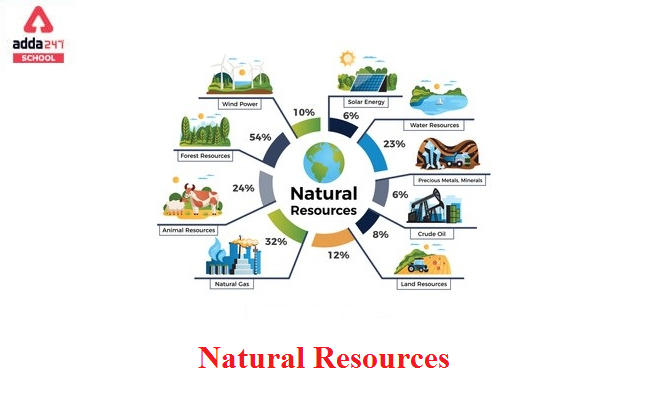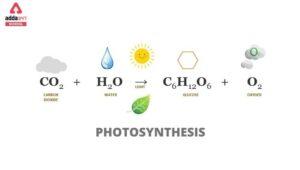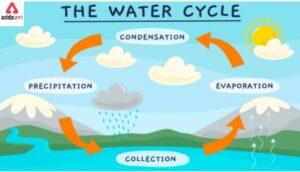Table of Contents
Natural Resources – Definition, Examples and Types all discribe here. Natural resources are ‘naturally-occurring resources’ that are developed without human interference. Air, sunlight, water, soil, stone, plants, animals, and fossil fuels are just a few examples of natural resources.
Resources
Resources are anything that has utility and adds value to Humans and living things life. Air, water, food, plants, animals, minerals, metals, and everything else that exists in nature and has utility to mankind is a ‘Resource’. It is of two types Natural and Man Made resources.
Types of Resources
Resources are assets or materials that are used to meet various human needs and wants. They can be classified into several categories based on different criteria. Here are some common types of resources:
- Natural Resources:
- Renewable Resources: These are resources that can be naturally replenished over time, such as sunlight, wind, water, and forests.
- Non-renewable Resources: These are finite resources that cannot be easily replaced, like fossil fuels (coal, oil, natural gas) and minerals (e.g., iron, copper).
- Human-made Resources:
- Human Capital: The skills, knowledge, and Products. (metals, wood, cement, sand, to make buildings, machinery, vehicles, bridges, roads, etc.)
Types of Resources with Examples
Resources can refer to a wide range of assets, materials, or information that can be used to achieve a particular goal. Here are examples of different types of resources:
- Natural Resources:
- Water: Used for drinking, agriculture, and industrial processes.
- Forests: Provide timber, paper, and habitat for wildlife.
- Minerals: Such as coal, iron, and oil, used in manufacturing and energy production.
- Renewable Energy Sources: Solar, wind, and hydropower for electricity generation.
- Human Resources:
- Labor: Skilled and unskilled workers who contribute to the production of goods and services.
- Knowledge and Expertise: The collective knowledge and skills of a workforce.
- Leadership: Effective leaders who guide organizations and teams.
- Talent: Creative and innovative individuals who bring unique skills to a project.
- Financial Resources:
- Money: Capital used for investment, operations, and growth.
- Investments: Stocks, bonds, and other financial assets.
- Loans and Credit: Borrowed funds for business or personal use.
- Budgets: Allocation of funds for specific purposes.
- Technological Resources:
- Hardware: Computers, servers, and devices used for data processing and communication.
- Software: Applications and programs for various tasks.
- Data: Information stored electronically, used for analysis and decision-making.
- Patents and Intellectual Property: Protected ideas and inventions.
- Information Resources:
- Databases: Collections of structured data for research and analysis.
- Libraries: Repositories of books, journals, and reference materials.
- Websites and Online Content: Information available on the internet.
- Reports and Studies: Research findings and reports relevant to a topic.
- Infrastructure Resources:
- Transportation: Roads, railways, and ports for moving goods and people.
- Utilities: Electricity, water supply, and sewage systems.
- Communication Networks: Telecommunication infrastructure for data and voice communication.
- Public Facilities: Schools, hospitals, and government buildings.
- Environmental Resources:
- Clean Air and Water: Essential for human and ecosystem health.
- Biodiversity: A variety of plant and animal species that contribute to ecosystem stability.
- Ecosystem Services: Functions of natural ecosystems that benefit humans (e.g., pollination, water purification).
- Land: Agricultural and natural landscapes used for various purposes.
- Social Resources:
- Community Support: Volunteer organizations and social services.
- Networks: Professional and personal connections that can provide assistance.
- Mentorship: Guidance and support from experienced individuals.
- Education and Training: Access to learning opportunities.
- Time:
- Productive Hours: The time available for work and other activities.
- Deadlines: Time constraints for completing tasks or projects.
- Scheduling: Efficient allocation of time for various activities.
- Cultural and Artistic Resources:
- Artifacts: Historical and cultural objects.
- Art and Music: Creative expressions of culture.
- Heritage Sites: Locations of historical or cultural significance.
- Language and Literature: Tools for communication and cultural preservation.
These are just a few examples of resources, and their importance can vary depending on the context, whether it’s in business, economics, environmental conservation, or daily life. Proper management and utilization of resources are crucial for sustainable development and achieving specific objectives.
Natural Resources
Natural resources are naturally occurring items that are beneficial to man or could be useful in possible technological, economic, or social circumstances, as well as supplies derived from the ground, such as food, building and clothing materials, fertilisers, metals, water, and geothermal power. Natural resources have long been the purview of natural scientists.
What are Natural Resources?
Natural resources are resources that are drawn from mother nature and used with few modifications in natural resources. Some common examples of natural resources include air, sunlight, water, soil, stone, plants, animals, and fossil fuels.
Types of Natural Resources
There are 2 types of natural resources based on their availability:
Renewable Type of Natural Resources
Renewable resources are those that are available in an endless quantity and can be used over and over again. Forest, wind, and water, for example.
Despite renewable energy is frequently considered a new technology, it has long been utilised for heating, transportation, and lighting. Windmills process grain and powerboats that sail the seas. During the day, the sun has brought warmth and has assisted in the lighting of fires that have lasted well into the evening. However, during the last 500 years or so, mankind has increasingly turned to dirtier, less expensive energy sources.
The different types of renewable resources include:
- Solar energy
- Hydro energy
- Tidal energy
- Geothermal energy
- Biomass Energy
Non-Renewable Type of Natural Resources
Non-renewable resources are restricted in quantity due to their non-renewable nature and their availability may run out in the future. Minerals, fossil fuels, and other natural resources are examples.
Oil, natural gas, coal, and nuclear energy are the main examples of nonrenewable resources. Fossil fuels are made up of oil, natural gas, and coal.
Natural Resources Examples
We need to conserve the natural resources, because:
- Irrational use and overuse of these natural resources have resulted in a number of socioeconomic and environmental issues.
- Natural resources are non-renewable and are only available in finite quantities.
- These natural resources are becoming increasingly scarce as the world’s population grows.
- Natural resources that aren’t renewable require millions of years to form.
Because these natural resources are depleting at an alarming rate, it is critical that we conserve them. Apart from that, it has a negative impact on the environment, which harms living beings indirectly.
We can, however, conserve these natural resources if we follow a few simple guidelines in our daily lives.
Some ways to help our nature in the conservation of the natural resources are as follows:
- Use a renewable energy source such as solar or wind energy.
- More trees should be planted to minimise soil erosion.
- Oil should be transported via pipes.
- Industrial sewage and waste are treated before being dumped into aquatic bodies.
- Include a rainwater collection system in your home.
- In the house, use biogas.
- Ascertain that the wastes are recycled.


 CBSE Class 12 Biology Viva Questions wit...
CBSE Class 12 Biology Viva Questions wit...
 Photosynthesis: Equation, Reaction, Diag...
Photosynthesis: Equation, Reaction, Diag...
 Water Cycle Diagram: Drawing for Kids of...
Water Cycle Diagram: Drawing for Kids of...






























